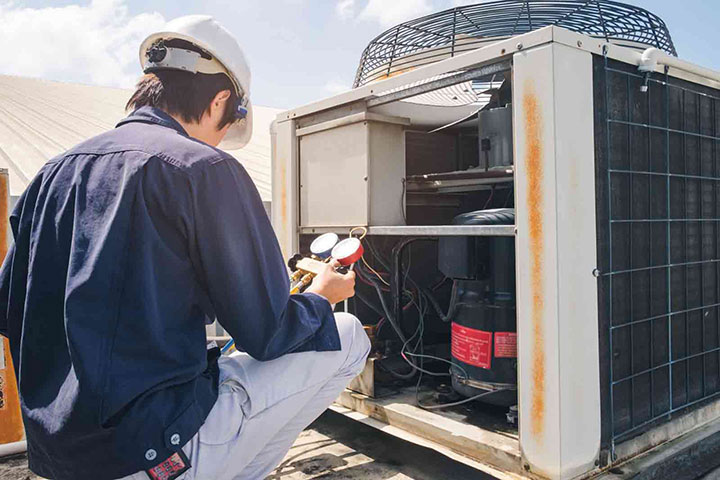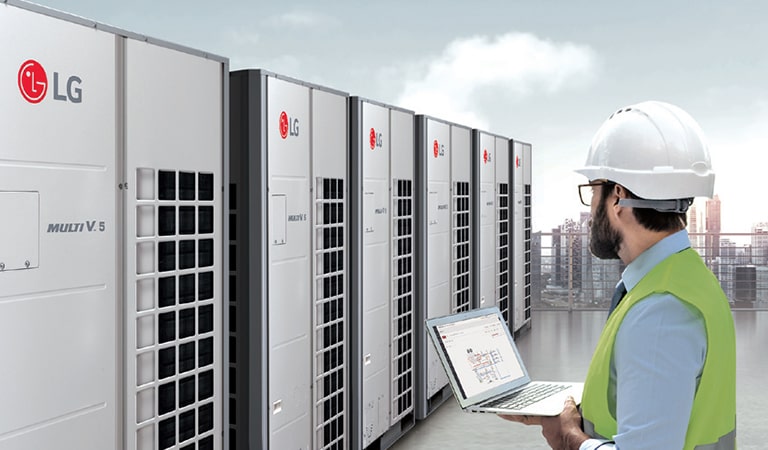The Homeowner’s Handbook to Installing ductless mini splits in Any Home Type
The Homeowner’s Handbook to Installing ductless mini splits in Any Home Type
Blog Article
Exactly How a Heatpump and Heater Job With Each Other to Optimize Your Home's Heating Performance
Comprehending exactly how a heatpump and heater work together is crucial for property owners seeking reliable heating options. Each system has its strengths, offering a balanced method to home convenience. The warm pump excels in modest temperature levels, while the heating system supplies fast warmth throughout extreme cold. This harmony not only reduces energy expenses but likewise boosts the lifespan of both appliances. What variables affect this partnership, and how can house owners maximize their advantages?
Comprehending Warmth Pumps: Exactly How They Work
Numerous individuals may be unfamiliar with their inner workings, heat pumps play a necessary role in modern-day heating systems. These tools run by moving warm from one location to another, making use of the concepts of thermodynamics. In chillier months, a heatpump removes warmth from the outdoors air, ground, or water, and transfers it indoors to warm the space. Conversely, throughout warmer months, it can reverse the process, serving as an air conditioning unit by expelling warmth from inside to the outside.Heat pumps are composed of an evaporator, condenser, expansion, and compressor shutoff. The refrigerant within the system absorbs heat as it evaporates at reduced temperature levels and pressures. The compressor then increases the stress and temperature level of the cooling agent, enabling it to launch heat as it condenses. This efficient process can considerably decrease power usage compared to standard home heating techniques, making warmth pumps a lasting selection for environment control in homes.
The Role of Heating Systems in Home Heating
Heaters play a crucial role in home heating by providing a trusted source of heat throughout the colder months. They run by generating heat with combustion or electric resistance, dispersing it throughout the home via ducts or glowing systems. The performance of a heating system is frequently measured by its Yearly Fuel Application Efficiency (AFUE) ranking, which indicates just how successfully the device converts fuel right into heat.Furnaces can make use of different power resources, including all-natural gas, lp, power, or oil, permitting property owners to choose one of the most appropriate option for their demands. Unlike heat pumps, which might battle in severe cool, heaters keep constant efficiency, making sure that interior temperatures continue to be comfortable no matter exterior conditions. Additionally, contemporary heaters usually come equipped with sophisticated innovation, such as variable-speed blowers and smart thermostats, improving their effectiveness and responsiveness. This versatility makes heaters an important element in all-encompassing home heating strategies.

Advantages of Utilizing Both Solutions Together
Integrating the staminas of both furnaces and heatpump can cause an extra effective and efficient home heating service. Utilizing both systems enables homeowners to make the most of the warmth pump's energy efficiency throughout milder temperature levels while counting on the heating system for more extreme cold problems. This twin technique can significantly lower energy costs, as warmth pumps consume less electrical power than standard heating techniques when temperature levels are moderate.Additionally, utilizing both systems together can enhance convenience levels in the home. Heatpump can supply constant, even heating, while heaters can quickly elevate ambient temperatures when needed. In addition, the assimilation of both systems can extend the lifespan of devices by lowering deterioration on each device, as they share the work. Inevitably, house owners can appreciate a balanced, cost-effective home heating option that readjusts effortlessly to differing weather, guaranteeing a cozy and inviting home throughout the wintertime months.
Just How Heat Pumps and Furnaces Enhance Each Other
They produce a corresponding home heating system that takes full advantage of performance and comfort when homeowners integrate warmth pumps and heaters. Heatpump operate by moving heat from the outdoors air or ground, making them very efficient in moderate environments. They stand out throughout milder temperatures, offering cost-efficient home heating. On the other hand, furnaces generate warmth via combustion or electric resistance, supplying strong, immediate heat during extreme chilly conditions.The combination of these 2 systems enables for vibrant changes based upon temperature level variations. Throughout warmer months or milder winter months days, the heat pump can take the lead, conserving power and lowering prices. As temperature levels drop, the furnace can seamlessly involve, ensuring constant warmth throughout the home. This synergy not only enhances power use however also improves the life expectancy of both systems, as each unit operates within its excellent efficiency variety. With each other, they create a well balanced environment that adapts to differing climate needs.
Maximizing Efficiency: Tips for Homeowners
Property owners can enhance their home heating efficiency with a number of useful techniques. Establishing a routine upkeep schedule, integrating smart thermostat modern technology, and carrying out effective insulation and securing services are crucial actions. These procedures not just improve comfort yet additionally minimize power costs.
Normal Maintenance Arrange
To guarantee optimal heating effectiveness, establishing a regular maintenance schedule is crucial for any type of home. Home owners need to focus on routine assessments of both heatpump and furnaces to establish peak efficiency. This includes altering air filters every one to three months, as clogged filters can considerably decrease efficiency. Furthermore, organizing expert upkeep a minimum of yearly allows specialists to identify and address possible concerns prior to they rise. Homeowners should also clean up the warm pump's outside device to stop particles buildup that can prevent air flow. By sticking to a regular upkeep timetable, homeowners not only enhance their heater' efficiency yet also expand their lifespan, bring about better convenience and reduced energy prices throughout the Source chillier months.
Smart Thermostat Combination
Incorporating a wise thermostat right into a home heater can greatly boost energy performance, particularly as it permits accurate control over temperature setups. These tools can learn the house owner's routine and preferences, immediately adjusting the temperature level to enhance convenience while decreasing energy use. They can lower heating during times when the home is vacant, lowering unnecessary consumption. Several clever thermostats likewise offer real-time energy usage data, making it possible for home owners to make informed decisions about their heating habits. In addition, remote access using mobile phone apps permits customers to adjust settings from Visit Your URL anywhere, making certain the home is warm upon return. Generally, wise thermostat combination not only boosts convenience however significantly contributes to power cost savings and efficiency.
Insulation and Securing Solutions
Smart thermostats play an essential role in power performance, but their effectiveness can be substantially improved by correct insulation and securing remedies. Property owners ought to focus on insulating floorings, attics, and wall surfaces to decrease warm loss. Top quality insulation materials, such as spray foam or fiberglass, can considerably improve thermal resistance. In addition, sealing spaces around doors, home windows, and air ducts prevents cold air infiltration and heat retreat. Weatherstripping and caulking are efficient techniques for attending to these leaks - heat pump replacement ooltewah tn. Regular assessments for air leaks, in addition to making use of blower door tests, can help determine problem areas. By purchasing insulation and securing, home owners can optimize the performance of their home heating systems, ultimately causing lowered energy intake and reduced utility costs
Typical Misconceptions Regarding Heat Pumps and Furnaces
What misconceptions surround heat pumps and furnaces? Several individuals mistakenly believe that warmth pumps are inefficient in cooler environments. Actually, modern heat pumps are created to operate successfully even in reduced temperatures, providing reliable home heating throughout winter months. One more usual myth is that furnaces are always extra efficient than warm pumps. Nevertheless, this relies on the specific power sources and efficiency scores of the systems in concern. Some might likewise believe that making use of both systems at the same time is unnecessary, but in fact, this mix can enhance heating performance, specifically during severe climate condition. In addition, individuals typically assume that warm pumps require constant maintenance, when truthfully, they have comparable maintenance requires to conventional home heating systems. By unmasking these misconceptions, house owners can make even more informed choices regarding their heating options, ultimately bring about improved comfort and energy performance in their homes.
Maintenance Factors To Consider for Combined Systems

Regularly Asked Inquiries
Can Heat Pumps Work Efficiently in Incredibly Cold Climates?
Heat pumps can have a hard time in extremely chilly climates due to lowered performance and warm removal limitations. Developments in technology have led to designs developed for far better performance in such problems, improving their stability in rough atmospheres.
How Much Time Do Heat Pumps and Furnaces Commonly Last?
Heatpump usually last 15 to two decades, while furnaces have a life-span of 15 to thirty years. Regular maintenance can extend their longevity, making certain reliable operation and reducing the requirement for premature substitutes.

What Is the Average Price of Installing Both Systems?
The typical cost of installing both a heatpump and a furnace typically varies in between $5,000 to $10,000 - heat pump replacement ooltewah tn. Elements influencing this price consist of system size, setup complexity, and local labor rates
Exist Tax Obligation Rewards for Utilizing Energy-Efficient Heating Solutions?
Numerous homeowners inquire regarding tax motivations for energy-efficient furnace. Different government and state programs commonly supply credit scores or rebates, encouraging the fostering of lasting technologies to reduce power usage and promote environmental responsibility.
Just how Do I Choose the Right Dimension Warmth Pump and Furnace?
Choosing the best size heatpump and heater includes calculating the home's square video, thinking about insulation high quality, and reviewing neighborhood climate. Consulting a specialist can ensure excellent system efficiency and energy efficiency view based on certain requirements. furnace replacement. Comprehending how a heat pump and furnace work together is vital for property owners seeking effective heating solutions. In colder months, a heat pump extracts heat from the outdoors air, ground, or water, and transfers it inside your home to warm the living area. When house owners integrate warm pumps and heaters, they produce a complementary home heating system that makes best use of effectiveness and comfort. Warmth pumps run by transferring warm from the outside air or ground, making them very reliable in modest climates. Warmth pumps can battle in exceptionally chilly climates due to decreased efficiency and warmth extraction limitations
Report this page